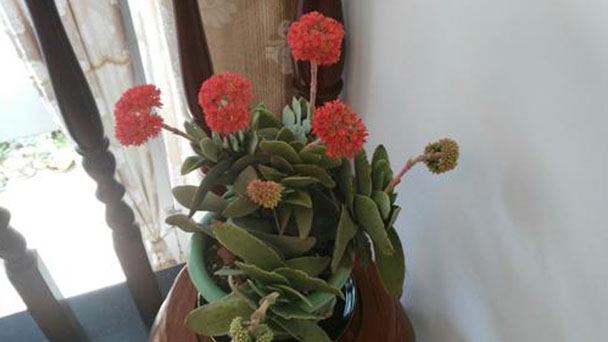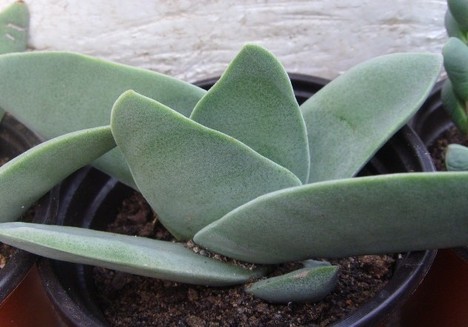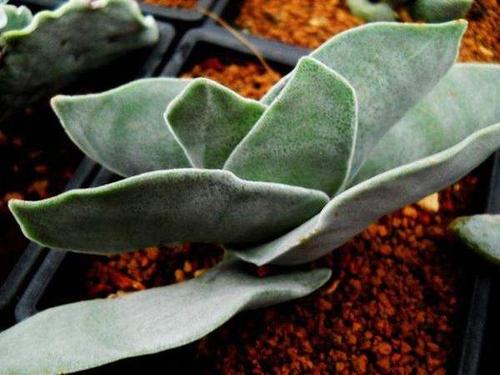Crassula Falcata "Propeller Plant" Care & Growing Guide
Written by Maggie
Oct 30 2021

Crassula Falcata "Propeller Plant" has thick and juicy leaves like sickle or Propeller, which is peculiar and interesting. It bloom bright orange flowers in summer, which is of high ornamental value and can be decorated with several cases, windowsills and writing desks. Crassula Falcata "Propeller Plant" has a long flowering period of more than a month. Because it can release oxygen to purify the indoor air, Crassula falcata is one of the few succulents that does well indoors. Plant it in a container near a sunny window.
How to grow and care for succulent Crassula falcata "Propeller Plant"? The first step is to understand the requirements for the growth of succulent Crassula falcata, such as the requirements for the environment, soil, lighting, watering and fertilization, which are described below.
| Common Name | airplane plant, propeller plant |
| Botanical/Scientific Name | Crassula falcata |
| Plant Type | Succulent |
| Mature Size | 2 feet tall |
| Light Requirements | Full sun |
| Soil | Well-drained Soil |
| Bloom Time | Summer |
| Flower Color | Orange flowers |
| Toxic | Generally non-toxic to humans and animals |
| Propagatiion | Propagated by leaves, cuttings, and offsets |
Crassula Falcata "Propeller Plant" Care
Crassula Falcata "Propeller Plant" prefers warm, dry and semi-shady environments. It is not resistant to cold and early drying. It is afraid of water accumulation and avoids bright light. When we care for propeller plant, the suitable temperature for succulent growth of crassula falcata is 15-20℃, and the ambient temperature in winter should not be lower than 5℃, otherwise it is difficult to overwinter safely.
Crassula Falcata Soil Care
The soil for Crassula Falcata's succulent home potted plants can be made from a 2:1:1 mixture of peat, sand and slag, which is beaten well during the mixing process. We can also add some ceramsite to the surface of the soil, keeping the soil well breathable.
Crassula Falcata Lighting Requirements
Crassula Falcata "Propeller Plant" is a succulent creature who likes to be exposed to sufficient light. If the temperature is up to 25 ° C in summer, shading is required and ventilation of the environment is enhanced. In winter, when the temperature is low, adequate light is required.
Crassula Falcata Watering
Crassula falcata succulents need to be well watered during the growing season. When caring for crassula falcata, keep the potted soil moist with frequent watering. Also, the potted soil should not be left dry for long periods in the summer and winter, and should be replenished promptly.
Because the fleshy roots of Crassula Falcata "Propeller Plant" are very thin, it is difficult to restore absorption in response to drought, and the leaves of Crassula falcata lose water and become soft if dried.

Crassula Falcata Fertilizer
When growing the succulent Crassula Falcata, we can apply fertilizer once a month. The fertilizer can be diluted cake fertilizer water or 15-15-30 special slow-release fertilizer for potted flowers. The nutrients can be replenished in time, which is conducive to the growth of the Crassula Falcata succulent.
Crassula Falcata Pruning Care
Crassula falcata's fleshy growth is so high that florists need to brace or remove the heart, otherwise the plant will bend and bow. Cut down the end branches of the plants for cottage propagation.
If the stem leaves of Crassula falcata are found to have fallen off, or if the plant cannot stand upright, the upper part of the plant, along with the leaves, is cut for cutting.
Crassula Falcata Pest Control
Crassula Falcata "Propeller Plant" mainly has grey mold damage to fleksy leaves. Spray 50% methyl tobutzine wettable powder 500 times liquid at the initial stage of development.
Indoor ventilation is not smooth, there will be whitefly harm, with 50% kill borer pine emulsion 1500 times the fluid spray kill.

Crassula Falcata Temperature Care
Crassula Falcata "Propeller Plant" is happiest growing in heat temperatures above 64°F (17° C). During the wintry weather months, it can continue to exist temperatures down to 20°F (-6.7°C).
Crassula Falcata Flowering
Propeller plant produces flora in the summer season and fall months. The velvety gray-green leaves develop in a twisted sample of contrary pairs, which are organized in an overlapping pattern.
Crassula Falcata "Propeller Plant" Propagation
The propagation method of the succulent Crassula Falcata "Propeller Plant" is generally used for propagation by cutting and seeding. Both methods are not difficult to operate. So how does Crassula Falcata "Propeller Plant" propagate? Detailed methods are described below.Propagate Crassula Falcata "Propeller Plant" from Cutting
First choose a full, tall and straight, healthy plant without insect pest leaves, and cut the leaves, put them in a cool and ventilated place to dry, then insert the Propagate Crassula leaves in the sand bed, generally about 15-20 days Falcata "Propeller Plant" can take root and germinate.At the same time, the blade of Crassula Falcata "Propeller Plant" can be cut into 5-6 cm long pieces. Similarly, after the blade incision is dried, it is placed on the wet sand surface for about 20 to 30 days, which will take root and sprout from the healing place of the blade and grow new branches.
Propagate Crassula Falcata "Propeller Plant" from Seed
The seed propagation of Crassula Falcata "Propeller Plant" is generally carried out in April and May in spring. Firstly, the seeds and soil of Crassula Falcata "Propeller Plant" are prepared. Throw the fleshy seeds of Crassula Falcata "Propeller Plant" directly into the soil, cover the seeds with fine soil, then cover them with a thin film, and then put the sand basin into a well-ventilated area.Latest Updated
- Benefits of Bugleweed - 7 Science-backed Health Benefits
- Bugleweed Dangers & Side Effects - Is It Poisonous?
- How to Plant Evergreen Trees - What You Should Know
- When to Plant Evergreens - Grow Guide for Evergreen Trees
- 12 Wonderful Evergreen Shrubs for Your Garden
- 12 Popular Evergreen Plants with Pictures for Beginners
- When And How To Prune A Lilac Bush Like a Pro
- How to Grow & Care for Lilac Vine (Hardenbergia Violacea)
- Japanese Lilac Tree (Syringa Reticulata) Care & Propagation Guide
- Shumard Oak Pros and Cons - What to Know
Popular Articles
- Winter maintenance of Antirrhinum Majus
- How to Grow Terminalia Mantaly Tree
- How to Grow and Care for Crossostephium Chinense
- How to grow Antirrhinum Majus in spring
- Peristeria Elata (Dove Orchid) Profile: Info & Care Guide
- Underwatered Snake Plant (Sansevieria Trifasciata) - Signs And How To Fix
- How to Care for Brazilian Jasmine Plant (Mandevilla Sanderi)
- How to Grow & Care for Graptopetalum Purple Delight in Summer
- Rosa Chinensis (China Rose): Plant Growing & Care Tips
- How to Care for Baby Sun Rose (Aptenia Cordifolia)